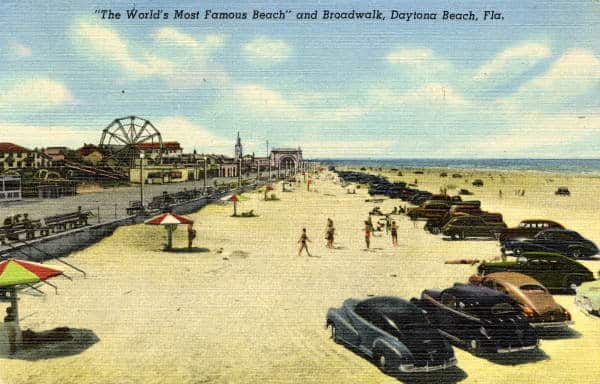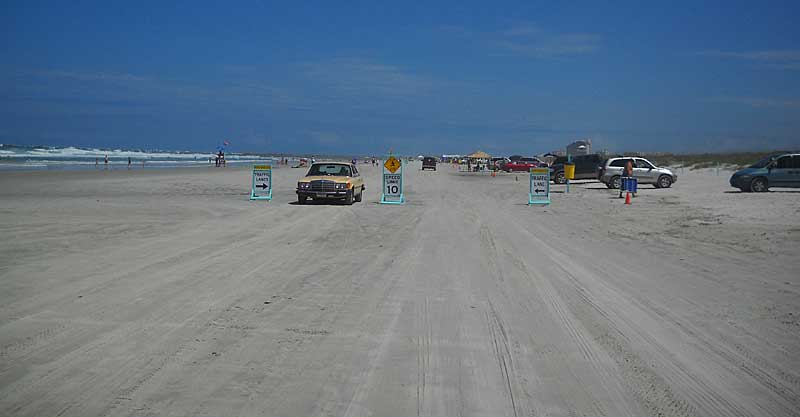Best Beaches With Car Access Near Jacksonville Fl
Last updated on March 22nd, 2021 at 08:16 pm
It is and always will be controversial.
But driving your car on the hard-pack sands of Daytona Beach, New Smyrna Beach and St. Augustine is a Florida tradition. Pioneers did it with horses and buggies. Stock car racers did it with roaring engines until 1959.
Thousands of people still drive on the beach every year. It is the ultimate scenic drive and a habit that Florida cherishes.

There are only a few dozen miles of beach left where driving is permitted. Over the years, many communities have ended the practice, and others are considering more restrictions due a recent rash of injuries and even deaths.
Driving on the beach is now possible only in Volusia County (Daytona Beach and New Smyrna Beach), Nassau County (Amelia Island), and St. John's County (summer only).
Driving on the beach in Daytona Beach and New Smyrna Beach

Vehicles pay $20 for the privilege and then cruise slowly right on the sand, which is amply wide and packed as hard as many roads. Annual passes for residents ($25) and non-residents ($100) are also available. For details, visit Volusia.org.
To park, pull over perpendicular to the beach in an area designated and then haul out the lawn chairs, tents, toys and gear. Park carefully and only on hard sand. Stay to the ocean side of the posts, and if the sand appears soft, give it up and park someplace else or you'll get stuck.
The south side of the Ponce Inlet jetty in New Smyrna Beach is a mecca for surfers, and the jetty itself is a magnet for fishing, so it's always crowded. Newbies try to double park, and many inevitably get stuck in the soft sand. While there is usually a friendly crowd to help rock you free (regulars bring shovels), it's not a fun way to spend your day, and it can be a dangerous exercise. Florida Rambler colleague Bob Rountree often visits this area, and he's been stuck in the soft sand more than once.
The surfing beach near the jetty is the area of New Smyrna Beach that has the dubious distinction of being the shark-bite capital of Florida. Sharks congregate around the inlet to feed on the tidal migrations of fish, sometimes mistaking surfboards for their prey. And there are plenty of surfboards.
"I once took my boat just outside the inlet to fish," Bob says. "After catching a half-dozen sharks and one barracuda inside of an hour, I gave it up. I also gave up swimming from the beach near the jetty."
You can also access a magnificent boardwalk near the south jetty that rises above a wide expanse of dunes, known as Smyrna Dunes Park. There are two miles of elevated boardwalk that skirt 73 pristine acres. The boardwalk is also accessible from the Coast Guard Station on Peninsula Avenue, two miles north of Flagler Avenue. Leashed pets are permitted on the boardwalk, but not the ocean beach. (There is a section of beach inside the inlet where pets are allowed.)
On the north side of the jetty — the Daytona side — is the Ponce de Leon Inlet Lighthouse and Museum, which is open at 10 a.m. every day. Closing times vary with the season.
In both New Symrna Beach and Daytona Beach, the areas where you are allowed to drive are clearly marked, with natural areas and select beach areas designated as no-drive zones. You pay a toll as you enter the beach, and if you leave one area, your pass allows you to re-enter on other access ramps.
There are five vehicle access ramps in New Smyrna Beach. Here's a map that shows areas where you can drive on the beach in New Smyrna Beach.
There are 16 access ramps off State Road A1A where you can enter the "driving zone" beaches in Daytona Beach. The longest drivable section is south of the Main Street Pier, from International Speedway Boulevard south to Emilia Avenue, just past Dunlawton Avenue. The crowded beaches around the Main Street Pier, once the focal point of stock-car racing on the sand, is now off-limits to vehicles. Here's where you can drive on the beach in Daytona Beach.
Tips on driving on the beach in Volusia County
- The speed limit is 10 mph
- Under no circumstances are you allowed to pass another car, even if it appears to have stopped. (This was learned the hard way.)
- There is two-way traffic: You can drive in either direction.
- Park perpendicular to the beach, but don't go beyond the posts into soft sand.
- Parking near Ponce Inlet on the New Smyrna side is limited, and soft sand plays havoc as people try to double park. Park a little further south and avoid the congestion.
- Driving is permitted sunrise to sunset from Nov. 1 to April 30, and from 8 a.m. to 7 p.m., May 1 through Oct. 31, tides permitting. Unusually high tides can close down driving.
- You can exit the beach and re-enter once without paying an additional fee.
- Regulations and information from Volusia County on driving on the beach.
Driving on the beach near St. Augustine
The spectacular beaches around St. Augustine permit beach driving from 8 a.m. to 7:30 p.m. March 2 to the end of September.
Cars can access the beach at these ramps:
- Vilano Access Ramp in Vilano
- Porpoise Point in Vilano)
- A Street in St. Augustine Beach
- Ocean Trace in St. Augustine Beach
- Dondanville in St. Augustine Beach
- Matanzas Avenue in St. Augustine Beach
- Mary Street in St. Augustine Beach
- Crescent Beach
There is no beach driving permitted on the beaches near Fort Matanzas or in Anastasia State Park.
St. Johns County offers daily ($10) and annual passes ($50 resident, $100 non-resident) to drive and park on beaches. Passes can be obtained from toll booth operators during the beach season.
Driving on the beach on Amelia Island
Beach access by vehicles on Amelia Island is now limited to Nassau County residents. (This is a change from the past, when non-residents could buy permits.)
The most popular spot on Amelia Island for driving onto the beach is Peter's Point Beach, 4600, Peters Point Road, Fernandina Beach. However, your only purpose will be to drive onto the beach and park. You won't drive far. The same is true for American Beach at Burney Park. These are beautiful beaches and Nassau County residents will enjoy parking on the sand with all their beach gear, but it's not an experience for visitors.
Driving on the beach near Jacksonville
There is one spot in Jacksonville (Duval County) where cars are still allowed on the beach — Huguenot Memorial Park, 10980 Heckscher Drive.
While environmentalists would like to end the practice to protect shore birds, this popular city park allows cars right on to beach.
The beach isn't a thoroughfare, as it is in New Smyrna and Daytona. It's more of a parking lot where folks coming to the beach for the day can bring all their toys.
A note from the editor:
The information in this article was accurate when published but can change without notice. Please confirm details when planning your trip by following the links in this article.
This article is the property of FloridaRambler.com and is protected by U.S. Copyright Law. Re-publication without written permission is against the law.
Best Beaches With Car Access Near Jacksonville Fl
Source: https://www.floridarambler.com/central-florida-getaways/driving-on-the-beach/#:~:text=There%20is%20one%20spot%20in,cars%20right%20on%20to%20beach.
0 Response to "Best Beaches With Car Access Near Jacksonville Fl"
Post a Comment